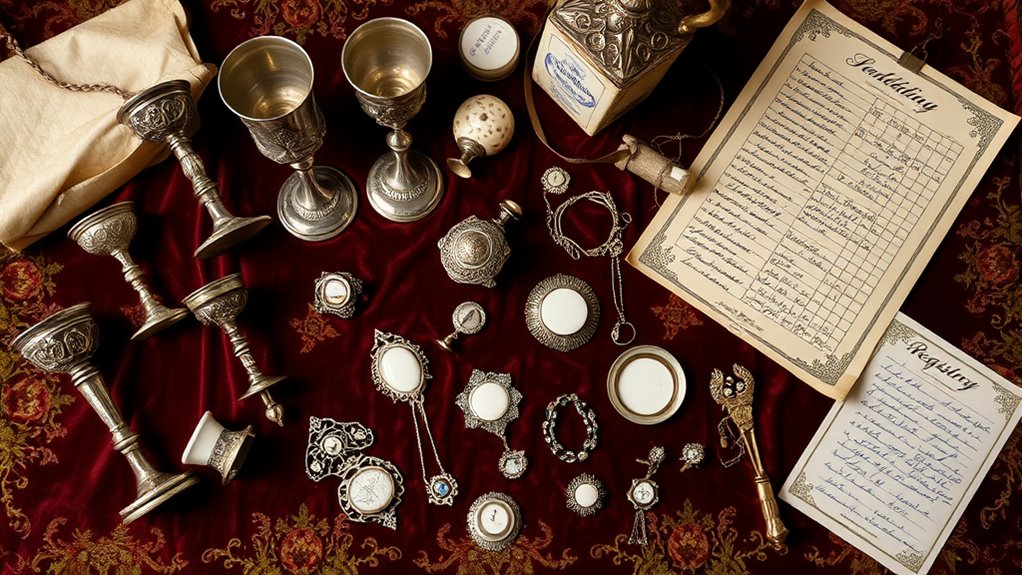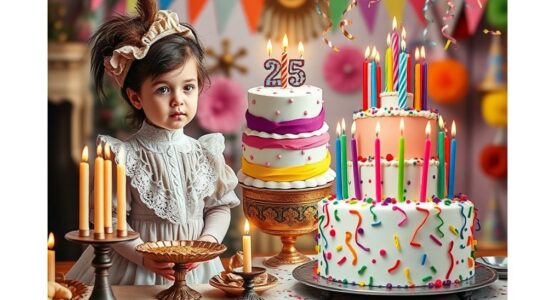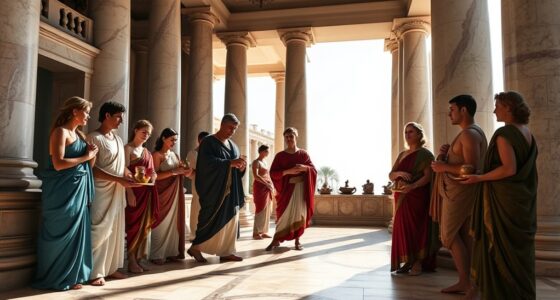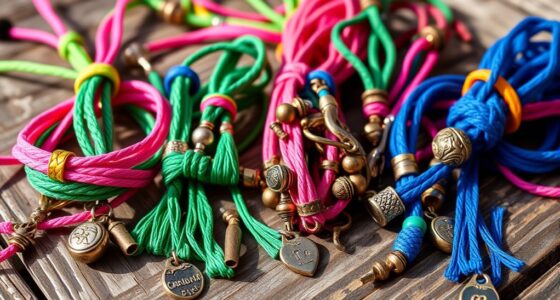Wedding gifts have evolved from ancient dowries and bride prices, which symbolized social status and family alliances, to modern gift registries focused on personal preferences. Over centuries, customs reflected cultural values and social hierarchy, with elaborate exchanges for nobility and simpler gifts for commoners. Today, gift registries and personalized offerings embody love, practicality, and tradition. To uncover how these traditions transformed over time, explore the fascinating journey from historic exchanges to contemporary wedding celebrations.
Key Takeaways
- Wedding gifts evolved from dowries and bride prices, symbolizing social status, mutual commitment, and family alliances.
- In medieval and traditional societies, gifts reflected wealth, reinforced social hierarchy, and fostered trust between families.
- Cultural variations influence wedding gift customs worldwide, showcasing regional values, rituals, and social identities.
- Modern practices shifted toward formal gift registries, personalized keepsakes, and experiential gifts to meet household needs.
- Technological advances now enable online, customizable, and eco-friendly wedding gift options, reflecting evolving social trends.
Ancient Beginnings: Dowries and Bride Prices
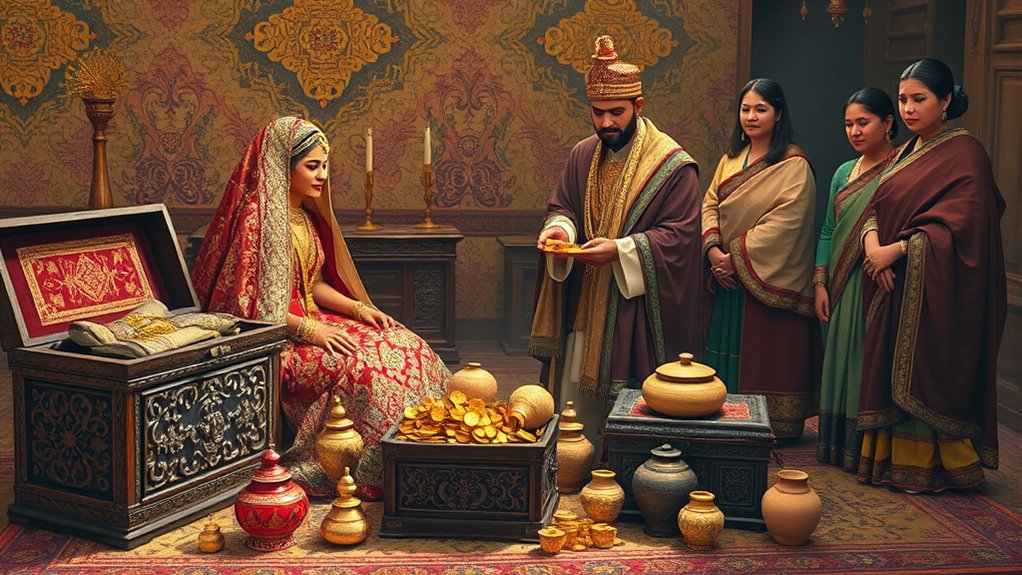
Long before modern wedding gifts became a tradition, societies relied on dowries and bride prices to symbolize mutual commitment and social standing. Ancient rituals often involved these exchanges as a form of gift symbolism, representing the union’s importance and the families’ alliance. A dowry, usually paid by the bride’s family, demonstrated her value and secured her future, while bride prices, paid by the groom’s family, reinforced the groom’s ability to provide. These exchanges weren’t merely financial; they carried cultural significance, affirming social bonds and status. The gifts served as tangible symbols of trust and commitment, emphasizing the importance of community and tradition in marriage. Over time, these ancient rituals laid the groundwork for the evolving customs surrounding wedding gifts today.
The Role of Gifts in Medieval Matrimony
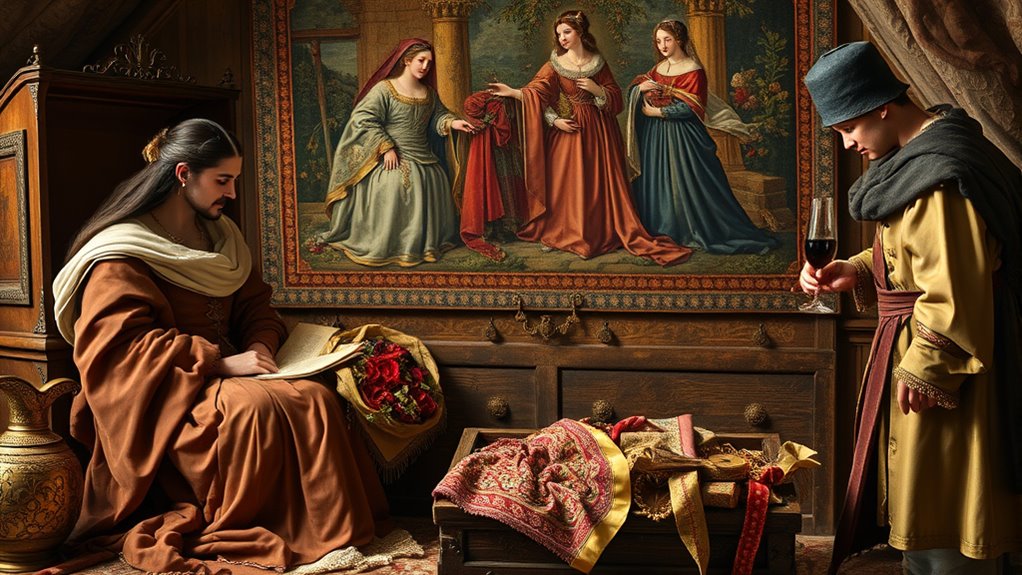
In medieval times, wedding gifts served as more than just offerings—they symbolized your social status and wealth. These gifts also helped strengthen family ties by establishing alliances and commitments. Understanding their role reveals how gifts shaped relationships and society during that era. Additionally, vetted practices ensured that these exchanges maintained their significance and social value over time.
Symbol of Social Status
During medieval times, wedding gifts served as clear indicators of social status, reflecting the wealth and rank of the families involved. These gifts functioned as luxury displays, showcasing the family’s prosperity and influence. They reinforced social stratification by visibly differentiating classes through the quality and quantity of offerings. Nobles and royalty often presented elaborate items—jewelry, fine textiles, and precious metals—demonstrating their elevated position. Such displays weren’t just celebratory; they communicated power and prestige to the community. For commoners, gifts were simpler but still symbolized their place within the social hierarchy. These tokens of wealth ultimately reinforced the established social order, making it clear who belonged to the upper echelons and who remained in the lower strata. Additionally, the presentation and exchange of gifts often reflected leadership skills such as negotiation and diplomacy, emphasizing the importance of social influence in medieval marriage alliances. The social significance of these gifts extended beyond mere exchange, serving as strategic tools to forge alliances and strengthen political bonds. Moreover, the types and value of gifts could also serve as indicators of wealth and influence, further cementing social distinctions.
Exchange of Wealth
Wedding gifts in medieval times often carried significant economic weight, serving as a formal exchange of wealth between families. These gifts, including luxury items like fine textiles, jewelry, and valuable goods, demonstrated the couple’s social standing and the family’s prosperity. Ceremonial offerings played a pivotal role, symbolizing the union’s stability and mutual support. The transfer of wealth through dowries and gifts helped solidify alliances and secure the couple’s future. Families viewed these exchanges as investments, reinforcing social bonds and demonstrating generosity. The emphasis on material wealth underscored the importance of economic stability in medieval marriage arrangements. Overall, these exchanges of wealth through luxurious gifts and ceremonial offerings underscored the economic significance intertwined with matrimonial unions during this period.
Strengthening Family Ties
Gifts in medieval marriage customs served more than just economic purposes; they actively strengthened family ties and reinforced social bonds. When you give or receive gifts, you influence interpersonal dynamics, signaling loyalty and trust between families. These exchanges helped create a sense of mutual obligation, fostering closer relationships beyond the immediate couple. The economic impact of gift-giving was significant, as it often involved substantial dowries or valuable presents that demonstrated wealth and status. Such acts of generosity reinforced alliances and established a network of social connections that could benefit both families for generations. In the context of medieval social hierarchy, these gift exchanges played a crucial role in maintaining social cohesion and promoting stability. By participating in these gift exchanges, you help maintain social cohesion, ensuring that familial bonds remain strong and respected within your community. Additionally, the value of gifts often reflected the social standing and intentions of the families involved, emphasizing the importance of strategic generosity. Furthermore, the tradition of gift-giving in marriage also helped to preserve cultural customs and uphold societal expectations surrounding kinship and alliance-building. Recognizing the significance of these exchanges can also provide insight into the broader economic implications of medieval marriage practices.
Cultural Variations in Wedding Present Traditions
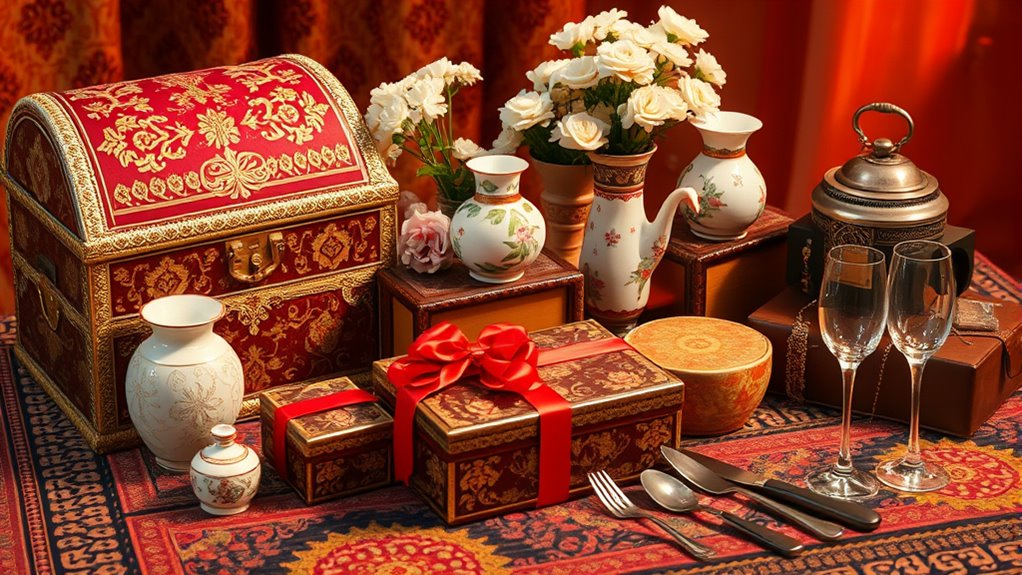
Cultural traditions shape the way couples celebrate their union through unique wedding present customs that vary widely around the world. These regional customs often reflect deep-rooted cultural rituals, highlighting the significance of marriage in each society. For example:
- In India, dowries and elaborate gifts symbolize prosperity and family ties.
- In Japan, gifts like money tucked into envelopes are customary, emphasizing respect and harmony.
- In Nigeria, traditional attire and symbolic items play a key role in ceremonies.
- In Mexico, giving gold jewelry or household items reinforces community ties and future stability.
Furthermore, understanding cultural significance behind these gifts can deepen appreciation for the traditions involved. Recognizing the history of wedding gifts across different societies adds context to these customs and their evolution over time. Exploring regional variations reveals how local influences shape wedding gift practices. Appreciating these diverse customs highlights how social values influence gift-giving traditions and strengthen cultural identity. Understanding these customs helps you appreciate the diverse ways cultures honor marriage, emphasizing that wedding presents are more than material; they’re expressions of cultural identity and social values. Additionally, the adaptation of customs over generations demonstrates how traditions evolve to meet contemporary societal needs.
Transition to Gift Exchanges in Early Modern Europe
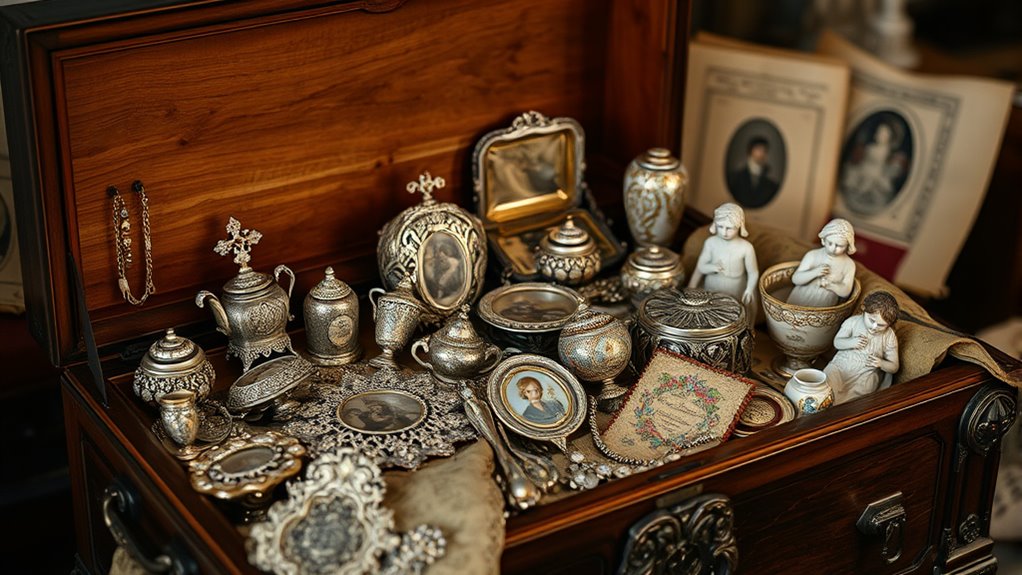
As Europe moved into the early modern period, the way people exchanged presents at weddings evolved considerably, reflecting broader social and economic shifts. Ceremonial exchanges became more formalized, often involving gift negotiation to display wealth and status. Instead of simple dowries or communal offerings, couples and their families began engaging in deliberate gift exchanges that signified alliances and social bonds. This progression fostered a sense of mutual respect and recognition, transforming wedding gifts into meaningful negotiations rather than mere transactions. The table below illustrates the emotional significance behind these exchanges: social customs
| Ceremony Type | Gift Negotiation Aspect | Emotional Impact |
|---|---|---|
| Dowry payments | Negotiating value | Security and stability |
| Bridal gifts | Personalization | Love and commitment |
| Family alliances | Social status | Pride and honor |
| Community offerings | Public acknowledgment | Belonging and reputation |
| Personal tokens | Sentimental meaning | Affection and remembrance |
The Rise of Formal Gift Registries in the 20th Century
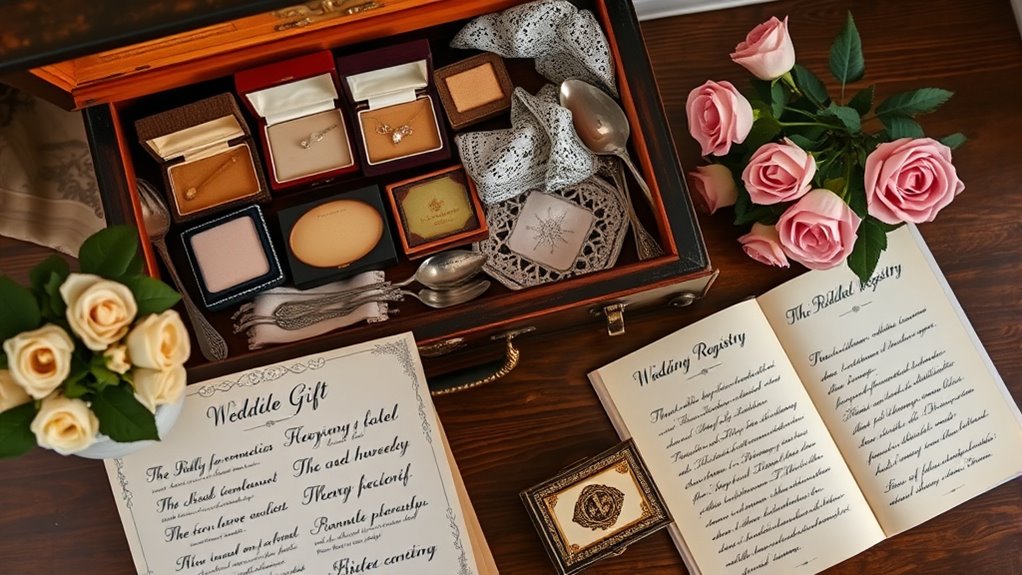
You’ll notice that formal gift registries became popular in the 20th century, offering a standardized way to select wedding gifts. Retailers began collaborating with couples to create curated lists, making gift choices easier and more predictable. This shift transformed how guests approached giving, aligning expectations with a streamlined, organized system. Additionally, the introduction of organized gift options helped reduce duplicate or unwanted presents, further enhancing the efficiency of gift-giving. The development of customizable registry systems allowed couples to tailor their lists to their specific needs and preferences. Incorporating space optimization principles, these registries often suggest items that help couples maximize their home organization and storage.
Standardized Gift Selection
The 20th century saw the emergence of formal gift registries, transforming how couples and their families approached wedding gifts. You now select a predetermined list of items, making gift-giving more streamlined. Here are four key aspects:
- Personalized keepsakes became popular, allowing couples to cherish meaningful mementos. These items often included custom engravings or family heirlooms that added sentimental value.
- Technological innovations enabled online registries, broadening gift options and accessibility. The integration of website performance metrics helped improve the user experience and ensure smooth navigation.
- Registries encouraged guests to choose practical, desired items, reducing duplicate or unwanted gifts. Dream analysis has also contributed to understanding personal preferences and subconscious influences, subtly shaping gift choices.
- Couples gained greater control over their household needs, creating a cohesive and functional start.
- The integration of cultural and regional traditions into gift selections enriched the uniqueness of each wedding, reflecting diverse backgrounds and preferences.
This shift fostered a sense of order and personalization, making gift selection more efficient and meaningful for everyone involved.
Retailer Collaboration Trends
During the 20th century, retailers recognized the growing demand for organized gift-giving and responded by forming formal partnerships with couples and wedding registries. They adopted luxury branding to appeal to aspirational consumers, emphasizing quality and exclusivity. These collaborations allowed retailers to implement targeted marketing strategies, making gift selection easier and more appealing for engaged couples. By offering curated lists, they enhanced the shopping experience, encouraging couples to register for specific items that reflected their lifestyles and status. Retailers also used advertising campaigns to promote the convenience and prestige of their registries, positioning themselves as essential partners in wedding planning. This trend transformed wedding gifts from informal exchanges into a sophisticated industry driven by strategic partnerships and luxury branding efforts. Additionally, the transparency in affiliate relationships encouraged trust and credibility, further boosting consumer confidence in purchasing through these registries.
Evolution of Wedding Gifts in Contemporary Society
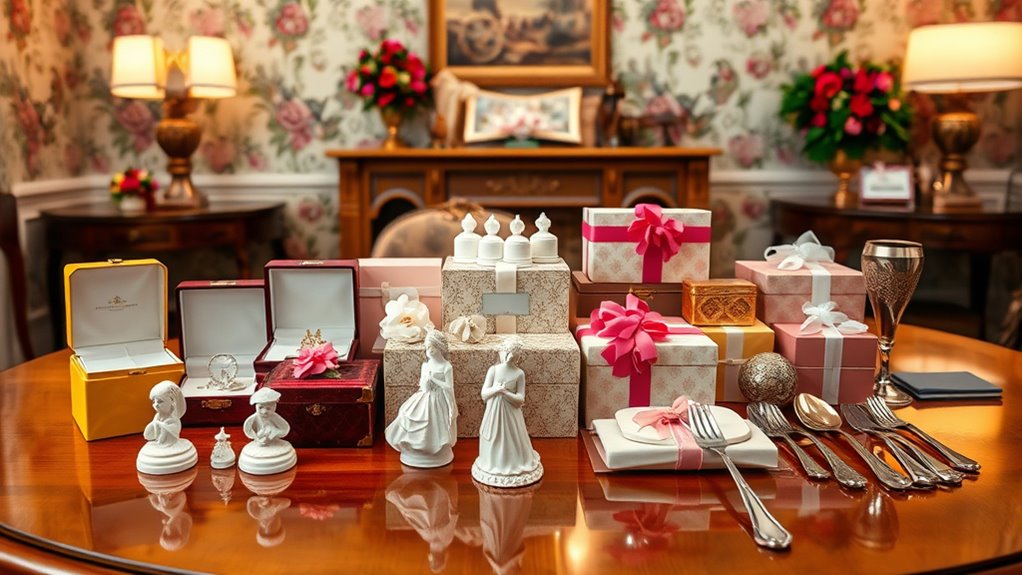
As societal norms and technological advances continue to reshape how we celebrate weddings, the tradition of giving gifts has also evolved considerably. Today, couples often prefer meaningful, personalized options that reflect their values. Here are some key trends:
- Charitable donations: Many guests now opt to give to causes important to the couple, making gifts more impactful.
- Honeymoon funds: Instead of traditional presents, couples create honeymoon funds for experiences like travel or adventures.
- Digital registries: Online platforms simplify gift selection and allow for diverse options, from household items to experiences.
- Experiential gifts: Gifts such as cooking classes or concert tickets focus on creating memories together.
These changes emphasize thoughtfulness and shared values, transforming wedding giving into a more meaningful act.
Symbolism and Significance Behind Wedding Offerings
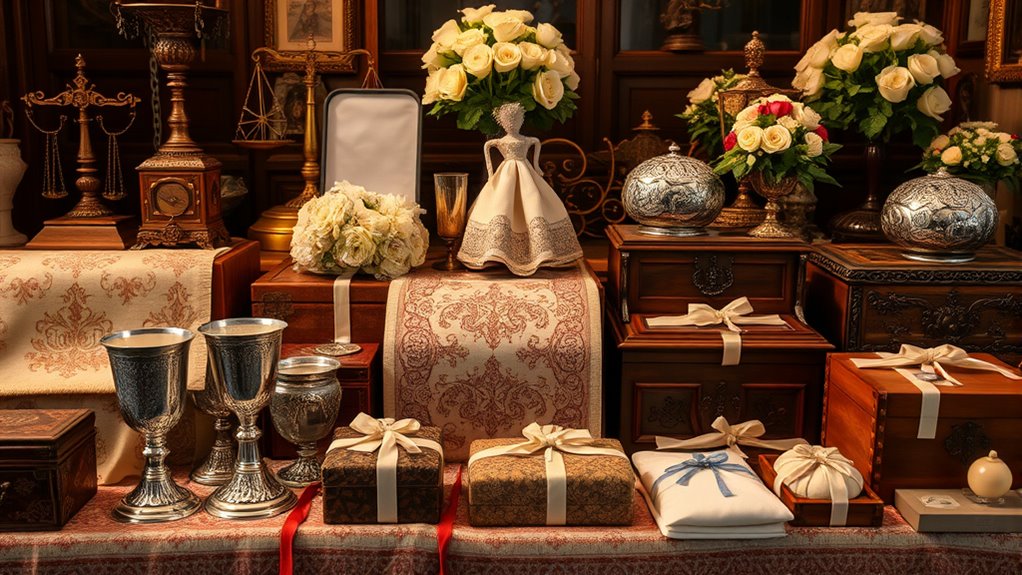
Wedding offerings carry deep symbolic meaning that reflects cultural values, shared beliefs, and hopes for the couple’s future. They often hold ritual significance, symbolizing prosperity, fertility, or protection. These gifts aren’t just material; they carry emotional value, representing blessings, support, and good wishes from loved ones. For example, a bride’s dowry might symbolize her family’s trust and hopes for her new life, while a gift of silver or gold signifies wealth and stability. In many cultures, specific items are chosen deliberately for their symbolic power, reinforcing community bonds and cultural identity. Ultimately, wedding offerings serve as tangible expressions of love, hope, and tradition, making the act of giving a meaningful ritual that connects the past, present, and future of the couple’s journey.
Future Trends in Wedding Gift Giving
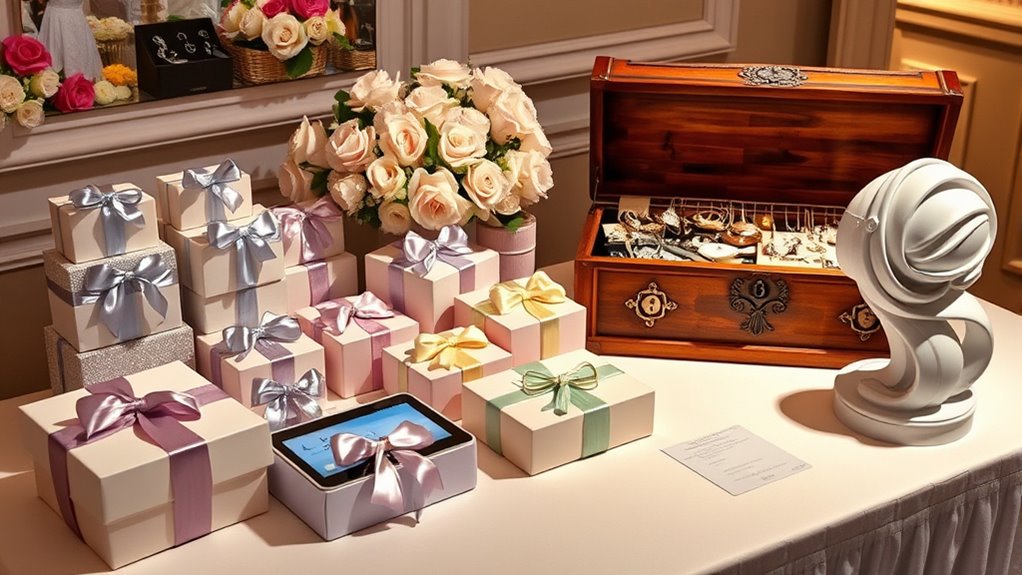
Looking ahead, the way couples and their loved ones approach wedding gifts is set to evolve considerably with technological advances and shifting cultural values. You’ll see more personalized options through digital customization, allowing you to tailor gifts to the couple’s tastes and needs. Eco-conscious gifting will also take center stage, emphasizing sustainability and mindful choices. Here are four trends to watch:
- Digital customization for unique keepsakes
- Eco-friendly gifts that promote sustainability
- Experience-based presents over material items
- Virtual gift registries accessible worldwide
These trends reflect a move toward meaningful, responsible giving that aligns with modern values, making your wedding gift more thoughtful and impactful.
Frequently Asked Questions
How Did Wedding Gifts Influence Social Status Historically?
Wedding gifts historically shaped social hierarchy and class distinctions, and you can see how they reinforced power. When you give or receive lavish gifts, it signals wealth and status, elevating your position within society. These exchanges often reinforced existing class distinctions, making social mobility more difficult. Through gift-giving, you participate in a system that both reflects and sustains social structures, emphasizing the importance of wealth and status in defining your place in society.
What Are Some Unique Wedding Gift Customs From Lesser-Known Cultures?
Ever thought wedding gifts are just about fancy china? Think again! In some cultures, gift symbolism plays a essential role, like the Maori presenting carved pounamu or the Yoruba exchanging symbolic cloths. Cultural rituals turn gift-giving into meaningful acts, showcasing respect and unity. You might be surprised how lesser-known traditions use unique items or rituals, turning simple presents into powerful symbols of love and community bonds.
How Have Modern Economic Changes Affected Wedding Gift Giving?
You might notice that modern economic changes, like inflation, influence wedding gift giving. As inflation rises, couples often receive more expensive gifts to keep up, leading to gift inflation. This trend reflects how economic shifts shape expectations, encouraging guests to spend more. You may feel pressured to give generously, but remember, thoughtful presents still hold value regardless of rising costs, maintaining the personal connection behind your gift.
Are There Any Traditional Wedding Gifts Still Considered Inappropriate Today?
You might wonder if traditional wedding gifts are still inappropriate today. Generally, culturally sensitive gifts and environmentally friendly presents are appreciated, but avoid items that could offend cultural or religious beliefs. Giving practical or personalized gifts is safe, while expensive or overly personal items might be seen as inappropriate. Keep your choice respectful, thoughtful, and aligned with the couple’s values to guarantee your gift is well-received.
How Do Online Registries Impact Traditional Gift-Giving Practices?
Ever wonder how online registries are changing gift-giving? They bring a new twist to tradition, blending digital gifting with gift registry trends. You might think it’s just convenience, but it’s also about anticipation—seeing exactly what the couple desires. This shift influences how people choose presents, making it more personalized. So, as you navigate modern wedding customs, remember that online registries shape the future, keeping tradition fresh and exciting.
Conclusion
As you look back through history’s tapestry, wedding gifts have woven stories of love, tradition, and cultural dance. From humble dowries to modern registries, each gift echoes a promise and a bond. Embrace the evolving rhythm of giving, knowing that every token carries the heartbeat of generations before you. In this dance of generosity, your gift becomes part of a timeless melody, celebrating love’s enduring song across ages and customs.
